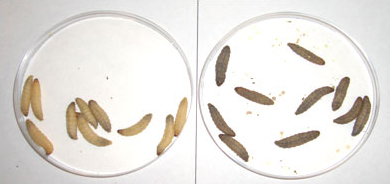In vivo Insect Model for Preclinical Toxicity studies/Pathogenicity Testing
We offer a rapid in vivo screening system for evaluating the virulence of microbial pathogens, the efficacy of antimicrobial drugs or the anti-inflammatory effects of novel compounds, as well as providing an in vivo model for early stage/pre-clinical toxicity studies.
The use of insects for screening microbial pathogens and for assessing the potency of anti-microbial drugs is now well established and has the advantage of giving results within 24 hours. Insect cells offer a simple in vivo model for pre-clinical toxicity studies.
Due to the strong structural and functional similarities between the insect immune response and the innate immune response of mammals, insects may be used in place of mammals and give comparable results. The use of insects in place of mammals is cost effective and does not have any of the ethical and legal requirements associated with the use of mammals.
Service
We offer a rapid (24 - 48 hours) screening service for measuring the in vivo and in vitro activity of microbial pathogens as well as potential antibiotics, immune-stimulants or vaccines. The system we provide can be used for a range of applications.
Microbial Challenge: Pathogencicity or virulence of both wild type as well as mutant strains of infectious microbes can be readily assessed in the insect model.
Anti-microbial Efficacy: Pretreatment of insect cells with potential antimicrobials can be used to assess the early stage potential of anti-microbial.
Toxicity of compounds: The effect of novel compounds on larval survival can be used as a measure of the likely response of mammals to the same compound and assist in identifying the optimum dose/range for mammalian testing.
Immuno-stimulant Efficacy: Immuno-stimulants will activate the innate immune system of insect cells. Potential immune-stimulants with health of clinical benefit can be readily assessed in a simple model. Biomarkers of immune-stimulation will be up regulated.
Vaccine: Pre-exposure of insect cells to potential vaccines can be used to assess vaccine potential following subsequent challenge with the organism of interest.
Gene deletion studies/ Alterations in gene expression: Analysis of changes in the expression of key genes can be used to measure the insect immune response to a pathogen or to an antimicrobial agent.
Alterations in microbial load: The growth of a microbe in the insect body can be used to quantify the relative virulence of the pathogen. This test is particularly useful when trying to measure small changes in the virulence of mutants.
Functional Tests
Larval Survival: The survival of larvae following challenge with microbial pathogens can be measured after 24 - 48 hours and the results correlate well with those that can be obtained with mammals.
Changes in haemoyte density and function: Haemocytes are cells of the insect immune system and are analogous to neutrophils in form and function. Fluctuation in the haemocyte density can be used to measure the alteration in the virulence of microbial mutants. Changes in the function of haemocytes (e.g. superoxide production) can be used to measure the anti-inflammatory properties of compounds.
Proteomic profile: Analysis of the insect proteome following infection or administration of a compound can give a good indication of the likely response of the mammalian immune response.
Superoxide Dismutase Assay: The ability of certain compounds to inhibit superoxide dismutase in insect immune cells.

